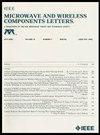5.9 mW E / w波段SiGe-HBT LNA, 48 GHz 3db带宽,4.5 db噪声系数
IF 3.3
2区 工程技术
Q2 ENGINEERING, ELECTRICAL & ELECTRONIC
引用次数: 4
摘要
介绍了一种采用130纳米硅锗(SiGe):C双极CMOS技术的毫米波(mm-wave)两级共射极(CE)低噪声放大器(LNA)的原理、设计和实现。LNA针对62至110 GHz宽带性能进行了优化,适用于毫米波雷达/传感和无线通信应用。采用两级宽带噪声和阻抗匹配技术,在E-/ w波段获得相对平坦增益(13.5 dB)和噪声系数(NF) (4.5 dB)。低电压$(V_{\text {CC}}=0.7\,\,\text {V})$和低功率(5.9 mW)运行是通过基极-集电极结正向偏置实现的,而利用恒定质量因子曲线的t型输入匹配网络进一步提高了宽带性能。据作者所知,本文提出的LNA具有最宽的3db带宽和文献中硅基E / w波段LNA的最低功耗。本文章由计算机程序翻译,如有差异,请以英文原文为准。
A 5.9 mW E-/W-Band SiGe-HBT LNA With 48 GHz 3-dB Bandwidth and 4.5-dB Noise Figure
The theory, design, and implementation of a millimeter-wave (mm-wave) two-stage common-emitter (CE) low noise amplifier (LNA) using a 130-nm silicon-germanium (SiGe):C Bipolar CMOS technology is presented. The LNA was optimized for wideband performance from 62 to 110 GHz for both mm-wave radar/sensing and wireless communication applications. A two-stage broadband noise and impedance matching technique is used to obtain a relativity flat gain (13.5 dB) and noise figure (NF) (4.5 dB) across the E-/W-band. Low-voltage $(V_{\text {CC}}=0.7\,\,\text {V})$ and low-power (5.9 mW) operation is achieved by forward biasing the base–collector junction, while the wideband capability is further improved by a T-type input matching network utilizing constant quality factor curves. To the best of authors’ knowledge, the presented LNA has the widest 3-dB bandwidth with the lowest power consumption in the literature for silicon-based E-/W-band LNAs.
求助全文
通过发布文献求助,成功后即可免费获取论文全文。
去求助
来源期刊

IEEE Microwave and Wireless Components Letters
工程技术-工程:电子与电气
自引率
13.30%
发文量
376
审稿时长
3.0 months
期刊介绍:
The IEEE Microwave and Wireless Components Letters (MWCL) publishes four-page papers (3 pages of text + up to 1 page of references) that focus on microwave theory, techniques and applications as they relate to components, devices, circuits, biological effects, and systems involving the generation, modulation, demodulation, control, transmission, and detection of microwave signals. This includes scientific, technical, medical and industrial activities. Microwave theory and techniques relates to electromagnetic waves in the frequency range of a few MHz and a THz; other spectral regions and wave types are included within the scope of the MWCL whenever basic microwave theory and techniques can yield useful results. Generally, this occurs in the theory of wave propagation in structures with dimensions comparable to a wavelength, and in the related techniques for analysis and design.
 求助内容:
求助内容: 应助结果提醒方式:
应助结果提醒方式:


